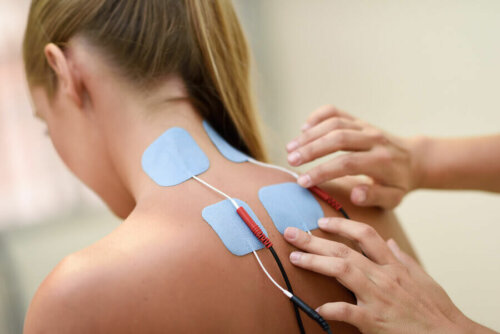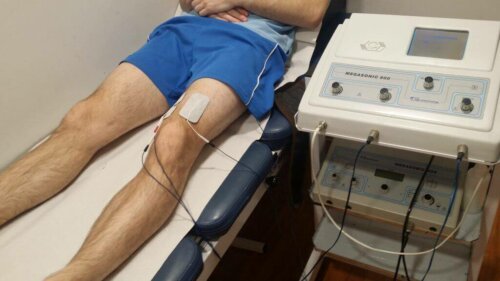Electroanalgesia and Local Modalities for Pain Relief

Electroanalgesia is an electricity-based pain relief method. It’s a therapeutic method that’s evolved a lot and is highly regarded. It’s a modality that complements other methods, as we’ll explain below.
The purpose of this type of technique is to inhibit acute pain by electricity, which interferes with the signals sent by the brain to the affected area. Moreover, the application of this treatment requires a prior and in-depth analysis of the patient. Few are resistant to it out of fear or ignorance.
Likewise, the medical professional needs to know the patient’s type of skin and any sensory disorder that they may suffer from. In short, it should be personalized for each individual and their circumstances.
Most successful local modalities of electroanalgesia
These are the most common electroanalgesia pain relief techniques and processes:
TENS (transcutaneous electrical nerve stimulation)
TENS is one of the most common modalities to reduce the pain that originates in the spine. When applied, constant impulses are produced to regulate or inhibit others that transmit pain signals.
In particular, this process is based on the gate control theory of pain. In other words, the electricity goes straight to the injury itself to avoid the perception of pain in other areas.
This modality is a great option for the following cases:
- Acute chronic pain.
- Lower back pain.
- Headache.
- Complex regional pain syndrome.
- Postoperative pain.
- Acute musculoskeletal pain (arthritis, myofascial pain, dysmenorrhea, etc.).
- Finally, neuropathic pain (tension headache, neuralgia, deafferentation pain syndromes, etc).
Experts don’t recommend this modality for pregnant women or people with pacemakers. Also, it shouldn’t be applied to areas close to the carotid sinus. In other patients, the only side effect is brief irritation at the application site.

Therapeutic ultrasound
By definition, ultrasound is a mechanical vibration with varying frequencies that emits sound waves through the skin. Experts use different drugs that seep through the skin to treat pain.
Through heat, it seeks to reduce pain and accelerate the healing process. Medical professionals usually use this technique for chronic lower back pain. In fact, it’s also a good option for cases in which the origin of the discomfort is unknown. The results are short-term and very beneficial, as they allow patients to continue with their routines.
Direct current or galvanization therapy
With this therapy, the current that reaches the body through the electrodes relaxes and activates the muscles. Thus, it uses a positively charged electrode to relieve localized pain.
Medical professionals can apply direct current or galvanization therapy alongside ultrasound. It all depends on the patient’s medical history and diagnosis. Medical professionals usually apply this form of electroanalgesia to the spine and limbs.
Depending on the patient and their case, the doctor either selects a transversal or longitudinal current. The goal is to sedate the swollen area. In patients with chronic pain, medical professionals place the cathode directly on the area to be treated.
High-frequency spinal cord stimulation (SCS)
This method can block pain signals. The electrodes are placed in specific areas, close to the spine. Also, a device is inserted into the skin. This way, it inhibits painful impulses to the brain.
Furthermore, high-frequency spinal cord stimulation (SCS) is a good option for back and leg pain. With this method, patients can avoid the constant tingling of low-frequency therapies. Its only downside is that it may cause irritation in the treated area.
Electroanalgesia is incresasingly progressing with the goal of improving people’s quality of life.

The mechanisms that electroanalgesia activates
The local pain relief modalities can act on their own or combined with others. They’re alternative therapies that immediately relieve the patient’s pain and allow them to regain mobility. For this to occur, the mechanisms that occur with electroanalgesia are:
- Sensory stimulation, produced by galvanic components that generate local anesthesia.
- Numbness of the nerves of the area, through which the electrical current circulates.
- Sensory stimulation, produced by the gateway effect without galvanic components.
- Contractions that improve blood circulation, relax muscles, and facilitate recovery.
In short, electroanalgesia is a pain relief method that’s advancing every single day. We can find increasingly sophisticated machines for this type of treatment on the market. The great thing about them is that they allow physiotherapists to help patients improve their quality of life.
Electroanalgesia is an electricity-based pain relief method. It’s a therapeutic method that’s evolved a lot and is highly regarded. It’s a modality that complements other methods, as we’ll explain below.
The purpose of this type of technique is to inhibit acute pain by electricity, which interferes with the signals sent by the brain to the affected area. Moreover, the application of this treatment requires a prior and in-depth analysis of the patient. Few are resistant to it out of fear or ignorance.
Likewise, the medical professional needs to know the patient’s type of skin and any sensory disorder that they may suffer from. In short, it should be personalized for each individual and their circumstances.
Most successful local modalities of electroanalgesia
These are the most common electroanalgesia pain relief techniques and processes:
TENS (transcutaneous electrical nerve stimulation)
TENS is one of the most common modalities to reduce the pain that originates in the spine. When applied, constant impulses are produced to regulate or inhibit others that transmit pain signals.
In particular, this process is based on the gate control theory of pain. In other words, the electricity goes straight to the injury itself to avoid the perception of pain in other areas.
This modality is a great option for the following cases:
- Acute chronic pain.
- Lower back pain.
- Headache.
- Complex regional pain syndrome.
- Postoperative pain.
- Acute musculoskeletal pain (arthritis, myofascial pain, dysmenorrhea, etc.).
- Finally, neuropathic pain (tension headache, neuralgia, deafferentation pain syndromes, etc).
Experts don’t recommend this modality for pregnant women or people with pacemakers. Also, it shouldn’t be applied to areas close to the carotid sinus. In other patients, the only side effect is brief irritation at the application site.

Therapeutic ultrasound
By definition, ultrasound is a mechanical vibration with varying frequencies that emits sound waves through the skin. Experts use different drugs that seep through the skin to treat pain.
Through heat, it seeks to reduce pain and accelerate the healing process. Medical professionals usually use this technique for chronic lower back pain. In fact, it’s also a good option for cases in which the origin of the discomfort is unknown. The results are short-term and very beneficial, as they allow patients to continue with their routines.
Direct current or galvanization therapy
With this therapy, the current that reaches the body through the electrodes relaxes and activates the muscles. Thus, it uses a positively charged electrode to relieve localized pain.
Medical professionals can apply direct current or galvanization therapy alongside ultrasound. It all depends on the patient’s medical history and diagnosis. Medical professionals usually apply this form of electroanalgesia to the spine and limbs.
Depending on the patient and their case, the doctor either selects a transversal or longitudinal current. The goal is to sedate the swollen area. In patients with chronic pain, medical professionals place the cathode directly on the area to be treated.
High-frequency spinal cord stimulation (SCS)
This method can block pain signals. The electrodes are placed in specific areas, close to the spine. Also, a device is inserted into the skin. This way, it inhibits painful impulses to the brain.
Furthermore, high-frequency spinal cord stimulation (SCS) is a good option for back and leg pain. With this method, patients can avoid the constant tingling of low-frequency therapies. Its only downside is that it may cause irritation in the treated area.
Electroanalgesia is incresasingly progressing with the goal of improving people’s quality of life.

The mechanisms that electroanalgesia activates
The local pain relief modalities can act on their own or combined with others. They’re alternative therapies that immediately relieve the patient’s pain and allow them to regain mobility. For this to occur, the mechanisms that occur with electroanalgesia are:
- Sensory stimulation, produced by galvanic components that generate local anesthesia.
- Numbness of the nerves of the area, through which the electrical current circulates.
- Sensory stimulation, produced by the gateway effect without galvanic components.
- Contractions that improve blood circulation, relax muscles, and facilitate recovery.
In short, electroanalgesia is a pain relief method that’s advancing every single day. We can find increasingly sophisticated machines for this type of treatment on the market. The great thing about them is that they allow physiotherapists to help patients improve their quality of life.
All cited sources were thoroughly reviewed by our team to ensure their quality, reliability, currency, and validity. The bibliography of this article was considered reliable and of academic or scientific accuracy.
- José María Rodríguez Martín. 2019. Apuntes de electroterapia. Extraído de: https://www.electroterapia.com/pdf/apuntes-electroterapia.pdf
- José María Rodríguez Martín. Dosificación en electroterapia. Extraído de: http://www.sld.cu/galerias/pdf/sitios/rehabilitacion-fis/dosificacion_en_electroterapia.pdf
- Bernal, Luis. Técnicas electroterápicas. Extraído de: http://www.sld.cu/galerias/pdf/sitios/rehabilitacion/tecnicas_electroterapicas_con_corrientes_de_baja,_media_y_alta_frecuencia..pdf
This text is provided for informational purposes only and does not replace consultation with a professional. If in doubt, consult your specialist.








